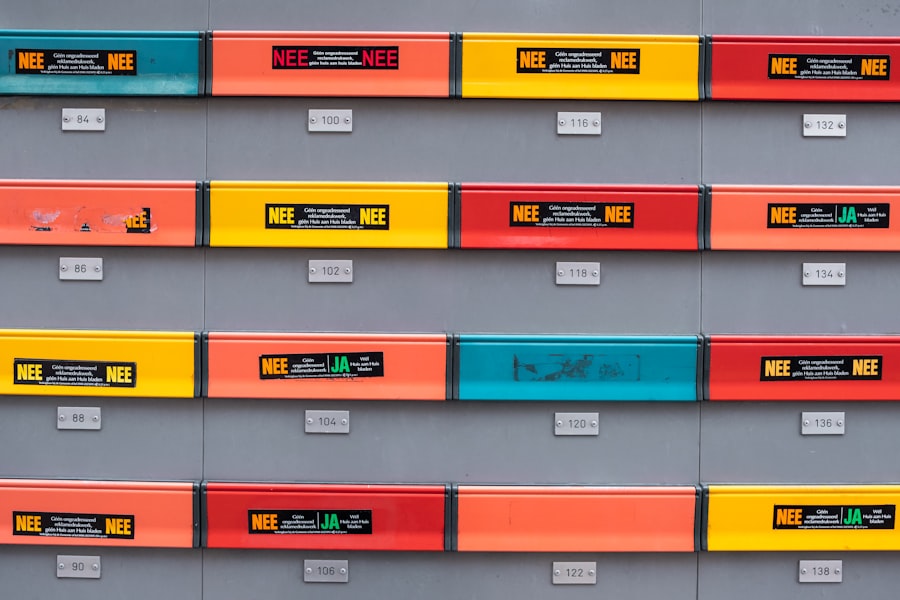When I think about the impact of direct mail on window covering businesses, I can’t help but feel a sense of nostalgia. There’s something inherently personal about receiving a piece of mail that’s specifically tailored to my interests. For window covering businesses, direct mail can be a game-changer.
It allows companies to reach potential customers in a way that feels intimate and direct, cutting through the digital noise that often overwhelms us. Unlike emails that can easily get lost in spam folders or ignored altogether, a well-crafted piece of direct mail has the potential to grab attention and spark interest. Moreover, direct mail can effectively showcase the unique offerings of window covering businesses.
Whether it’s a stunning photograph of custom drapes or an eye-catching design of blinds, the tactile nature of physical mail allows for a more immersive experience. I’ve found that when I hold something in my hands, I’m more likely to engage with it. This is particularly true for products like window coverings, where visuals play a crucial role in decision-making.
By sending out beautifully designed brochures or postcards, businesses can create a lasting impression that encourages potential customers to explore their offerings further.
Key Takeaways
- Direct mail can have a significant impact on window covering businesses by reaching a targeted audience and driving sales.
- Understanding the target audience is crucial for effective direct mail campaigns, as it allows for personalized and relevant messaging.
- Eye-catching and persuasive design is essential for direct mail materials to capture the attention of recipients and drive engagement.
- Utilizing data and analytics can inform direct mail strategies by providing insights into customer behavior and preferences.
- Implementing personalization and customization in direct mail campaigns can increase the effectiveness of the marketing efforts and drive customer engagement.
Understanding Your Target Audience for Effective Direct Mail Campaigns
Demographics and Purchasing Decisions
For instance, young families might prioritize durable and easy-to-clean options, while older homeowners may focus on aesthetics and energy efficiency. This variation in preferences highlights the importance of considering demographics when crafting direct mail campaigns.
Psychographics and Targeted Campaigns
Psychographics also play a vital role in understanding the audience. By exploring their interests and lifestyle choices, it’s possible to create more targeted campaigns that resonate with potential customers on a deeper level. For example, if the audience values sustainability, highlighting eco-friendly materials in direct mail pieces can be an effective approach.
Building a Connection with the Audience
This level of understanding enhances the effectiveness of campaigns and fosters a connection with the audience that goes beyond transactions. By taking the time to understand the target audience, it’s possible to create meaningful relationships and increase the likelihood of successful direct mail campaigns.
Designing Eye-Catching and Persuasive Direct Mail Materials

When it comes to designing eye-catching and persuasive direct mail materials, I’ve discovered that creativity is key. The first thing I consider is the visual appeal of the piece. Bold colors, striking images, and clean layouts can make a significant difference in capturing attention.
I often find inspiration from successful campaigns in other industries, noting how they use design elements to convey their message effectively. For window coverings, showcasing high-quality images of products in beautifully decorated spaces can evoke emotions and inspire potential customers to envision those products in their own homes. However, design is only part of the equation; the messaging must also be compelling.
I’ve learned that clear and concise language is essential. Potential customers should immediately understand what I’m offering and why it matters to them. Including a strong call-to-action is crucial as well—whether it’s encouraging them to visit my website, call for a consultation, or take advantage of a limited-time offer.
By combining eye-catching design with persuasive messaging, I can create direct mail materials that not only attract attention but also drive action.
Utilizing Data and Analytics to Inform Direct Mail Strategies
In today’s data-driven world, utilizing data and analytics has become indispensable for informing direct mail strategies. I’ve found that analyzing past campaign performance can provide valuable insights into what works and what doesn’t. For instance, tracking response rates from different demographics allows me to refine my target audience further.
By understanding which segments are most responsive to my campaigns, I can allocate resources more effectively and increase the overall return on investment. Moreover, leveraging data helps me stay ahead of trends in the window covering industry. By monitoring market research and consumer behavior data, I can identify emerging preferences and adjust my offerings accordingly.
For example, if data shows a growing interest in smart home technology, I can highlight automated window coverings in my direct mail campaigns. This proactive approach not only keeps my business relevant but also positions me as an authority in the industry.
Implementing Personalization and Customization in Direct Mail Campaigns
One of the most exciting aspects of direct mail marketing is the ability to implement personalization and customization. I’ve learned that addressing recipients by name and tailoring content based on their preferences can significantly enhance engagement rates. For instance, if I know a customer has previously purchased roller shades, sending them a postcard featuring new styles or complementary products can create a sense of connection and relevance.
Customization goes beyond just names; it involves creating unique experiences for each recipient. I often consider segmenting my mailing list based on factors like location or previous purchases. This allows me to send targeted offers that resonate with specific groups.
For example, if I have a segment of customers living in urban areas, I might highlight space-saving solutions like vertical blinds or sheer curtains that cater to their needs. By making recipients feel valued and understood, I can foster loyalty and encourage repeat business.
Measuring the Success of Direct Mail Efforts and Adjusting Strategies

Measuring the success of my direct mail efforts is crucial for continuous improvement. I’ve found that tracking key performance indicators (KPIs) such as response rates, conversion rates, and return on investment provides valuable insights into how well my campaigns are performing. For instance, if I notice that a particular campaign generated a high response rate but low conversions, it may indicate that while people are interested, there’s something about the offer or follow-up process that needs adjustment.
Additionally, gathering feedback from customers who respond to my direct mail campaigns can provide qualitative insights that numbers alone cannot capture. I often reach out to customers who made purchases after receiving direct mail to ask what influenced their decision. This feedback loop allows me to refine my strategies further and ensure that future campaigns resonate even more effectively with my audience.
Overcoming Common Challenges in Direct Mail Marketing for Window Covering Businesses
While direct mail marketing offers numerous benefits, it’s not without its challenges. One common hurdle I’ve encountered is the perception that direct mail is outdated or less effective than digital marketing channels. To overcome this challenge, I focus on integrating direct mail with my overall marketing strategy rather than viewing it as a standalone effort.
By combining direct mail with digital campaigns—such as social media ads or email follow-ups—I can create a cohesive experience that reinforces my message across multiple touchpoints. Another challenge is managing costs associated with printing and mailing materials. To address this concern, I’ve learned to be strategic about my budget allocation.
Investing in high-quality materials is essential for making a strong impression, but I also look for ways to optimize costs without sacrificing quality. For instance, using targeted mailing lists ensures that I’m reaching the right audience without overspending on broad distribution.
Leveraging Direct Mail to Build Long-Term Customer Relationships and Loyalty
Ultimately, leveraging direct mail is about building long-term customer relationships and fostering loyalty. I’ve found that consistent communication through direct mail helps keep my brand top-of-mind for customers even after their initial purchase. Sending out seasonal promotions or informative newsletters not only provides value but also reinforces the idea that I care about their needs beyond just making a sale.
Additionally, incorporating loyalty programs into my direct mail strategy has proven effective in encouraging repeat business. By offering exclusive discounts or rewards for returning customers through personalized mailings, I create an incentive for them to choose my business again when they need window coverings or related services. This approach not only boosts sales but also cultivates a sense of community around my brand—something that’s invaluable in today’s competitive market.
In conclusion, direct mail marketing holds immense potential for window covering businesses looking to connect with their audience meaningfully. By understanding my target audience, designing compelling materials, utilizing data-driven strategies, personalizing content, measuring success, overcoming challenges, and fostering long-term relationships, I can harness the power of direct mail to drive growth and build lasting customer loyalty.
If you’re looking to perfect your drapery installation techniques, check out this article on Perfecting Your Drapery Installation: Best Practices and Common Pitfalls. This resource provides valuable insights and tips for window treatment professionals to ensure successful installations every time. Additionally, for more marketing strategies and secrets tailored specifically for window treatment professionals, be sure to read Marketing Tips, Tricks, and Secrets for Window Treatment Professionals. And to learn more about the Window Covering Professionals Association and how they can support your business, visit their website at https://wcpa.me/about-us/.
FAQs
What is direct mail marketing?
Direct mail marketing is a form of advertising where businesses send promotional materials, such as postcards, flyers, or catalogs, directly to potential customers through the postal service.
How can direct mail revitalize a window covering business?
Direct mail can revitalize a window covering business by targeting specific demographics or geographic areas with tailored promotional materials. This can help increase brand awareness, generate leads, and drive sales for the business.
What are the benefits of using targeted direct mail campaigns for a window covering business?
Targeted direct mail campaigns allow window covering businesses to reach potential customers who are more likely to be interested in their products. This can result in higher response rates, increased customer engagement, and a better return on investment compared to mass marketing efforts.
What are some examples of targeted direct mail campaigns for a window covering business?
Examples of targeted direct mail campaigns for a window covering business include sending promotional materials to homeowners in specific neighborhoods, offering discounts to customers who have previously purchased window coverings, or creating personalized mailers for customers based on their preferences and purchase history.
How can businesses measure the success of their direct mail campaigns?
Businesses can measure the success of their direct mail campaigns by tracking response rates, monitoring sales and leads generated from the campaign, and using unique promotional codes or phone numbers to attribute customer actions to the specific mailer they received.


